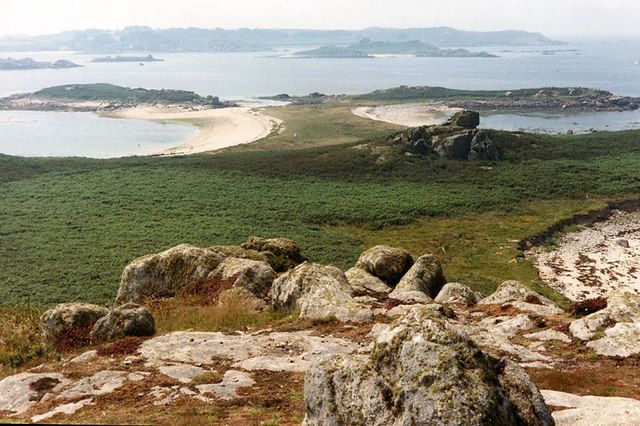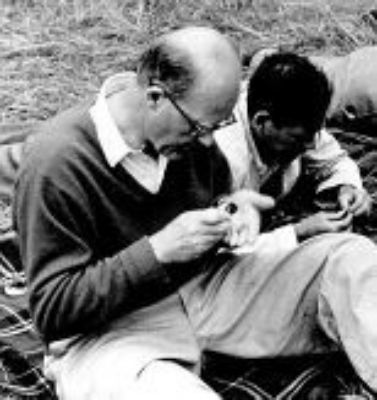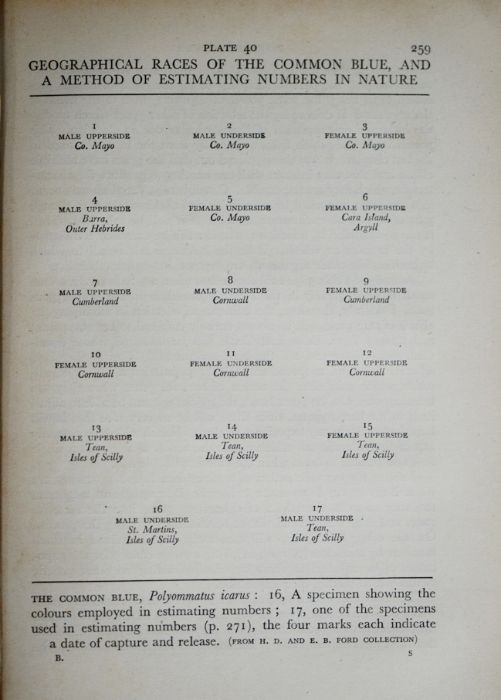The uninhabited Isle of Tean in the Isles of Scilly archipelago which lies close to the larger Island of St Martin's, had a unique form of the Common Blue Polyommatus icarus where the females in the Summer brood at least, comprised of examples showing a beautiful silvery blue.
Professors E.B. Ford and W. H. Dowdeswell camped on the Island of Tean between 26 August to 8 September 1938 where they made ground breaking studies of Maniola jurtina, which is represented on Tean by subspecies cassiteridum (Graves 1930), an endemic of the Isles of Scilly. The eminent duo were also here to study the population of Polyommatus icarus by their new mark and re-capture experiments, with the use of paint. Ford noticed that the females of the P. icarus were remarkable in their appearance. Ford wrote in his seminal work, 'Butterflies' in the New Naturalist series, first published in 1945 that.
" A remarkable race inhabits the tiny granite island of Tean in the Scillys. I have not collected on, or seen specimens from, all the islands of that group which it could inhabit, but the normal form is found on St Mary's, Tresco, and even St Martin's which is only 300 yards from Tean at one point, though elsewhere the shores fall away from one another rapidly. This isolation is not very surprising, for the species is not at all migratory, and Mr W.H. Dowdeswell and I obtained considerable evidence, from marking and releasing specimens that the populations on these two neighbouring Islands are effectively distinct. In the case of the majority of the females obtained in the summer (I have no knowledge of the spring form) have an extensive scattering of pale silvery-blue scales, so that they are most unlike those found elsewhere, which are either blackish or else marked with a violet shade. Moreover, the form from Tean is associated with a characteristic variation on the under-side of the hind-wings, which affects both sexes; for in a large proportion of the specimens the two spots placed along the coastal margin are united, forming a short curved line, and other varieties in spotting are frequent. We seem here to have a stage in the evolution of an independent sub-species".
It is surprising that Ford's announcement of a new and striking British race of P. icarus did not excite the interest of other lepidopterists to visit Tean but Britain had just spent five long years struggling for its survival against Hitler's Nazi hoards. In post war Britain, Ford's special race of P. icarus seems to have been largely forgotten.

Edmund Brisco "Henry" Ford (1901-1988)
Even though R.L.H. Dennis in his book ' The British Butterflies, Their Origin and Establishment published during 1977 mentioned Ford's discovery, of a new race of P. icarus on Tean, it was not until 1995 that someone decided to go to look for Ford's special blue. Over half a century after Ford and Dowdeswell had made their discovery Ruperb Barrington of Bristol decided in August 1995 to visit the island of Tean and search for Ford's silvery-blue female icarus. Barrington published his account of his visit to Tean in the Entomologist's Record and Journal of Variation ( Vol 108,1955). Barrington had difficulty in getting to the Island but on a blazing hot morning he stepped ashore on Tean. When Ford had been here, a herd of cattle were grazing the Island but on his visit to Tean, Barrington found that there had been a drastic changes in the habitat, he wrote
" it was immediately obvious that the island flora had since undergone great changes. When he (Ford) worked there a herd of cattle grazed the island keeping back the rank growths of bramble and bracken that seem to take over any area on the islands that is not cultivated or grazed. Large areas of grasses were maintained, within which grew the foodplant lotus corniculatus. The cattle were removed in 1950 and the vegetation has changed disastrously. The island is dominated by thick bracken and bramble with long coarse grasses around the very perimeter and covering a sandy bar at one end of the island. Despite careful search I was only able to find four females and six male icarus, all of the typical form. The foodplant was very scarce and the habitat looked quite unsuitable for this species."

Tean today. Note the extent of the bramble & bracken which is absent in Ford's black and white image of Tean in 1938, shown on Plate XXIV of his Butterflies (1945) facing page 303.
Barrington (1995) also tell us " Dowdeswell, in his work the 'Life of the Meadow Brown' (1981) reports that in August 1938 he and Ford estimated the population of P. icarus to be between 450-500 adults. They also estimated the population of M. jurina as being around 8650. I only saw only small numbers of jurtina and the population must be far below those old records".

Wilfrid Hogarth Dowdeswell (1914-1996)
Barrington suggested that the Ford's unique female form of P. icarus became extinct on Tean through habitat change. Recent images of Tean show the Island still covered in bracken and bramble. Today the island is managed by the Scilly Wildlife Trust but it seems to have been too late for the unique silvery blue female form of the Common Blue that once occurred on that Island and also for the abundant sea bird species that once bred there.
Conclusion.
R. Parslow, in his volume, The Isles of Scilly (2007) in the New Naturalist Library, wrote "Recent visits have not found the Common Blue to be significantly different on Tean so Ford’s remarkable form no longer seems to exist; unusual female colour forms and aberrations may just occur more frequently on Scilly than elsewhere". As the population of P. icarus declined on Tean, because the habitat became unsuitable, the special form that once comprised the majority of the females was lost. Female forms were represented by syngrapha and semi-syngrapha in Lysandra coridon in some British colonies but unlike the P. icarus population on Tean, they only formed a small percentage of the population. Both syngrapha and semi-syngrapha are rarely encountered today within the British populations of L. coridon because of the decline of the colonies where they occurred.


Plate 40 from E.B. Ford's ' Butterflies' (1945) showing specimens of Geographical races of P. icarus including the Isle of Tean. Figure 15, shows the unique colour of a female that once was a feature of the Isle of Tean population.
Peter.

